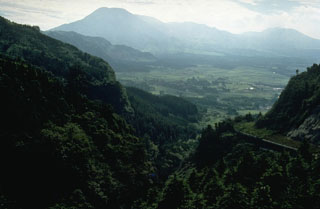Report on Asosan (Japan) — May 1992
Bulletin of the Global Volcanism Network, vol. 17, no. 5 (May 1992)
Managing Editor: Lindsay McClelland.
Asosan (Japan) Mud/water ejections from heating crater lake; tremor episodes
Please cite this report as:
Global Volcanism Program, 1992. Report on Asosan (Japan) (McClelland, L., ed.). Bulletin of the Global Volcanism Network, 17:5. Smithsonian Institution. https://doi.org/10.5479/si.GVP.BGVN199205-282110
Asosan
Japan
32.8849°N, 131.085°E; summit elev. 1592 m
All times are local (unless otherwise noted)
Isolated volcanic tremor episodes began to increase in October 1991, reaching about 100 events/day by the end of May. The increase in seismic activity followed a period of quiet after the July 1989-December 1990 eruptive phase. Ejections of mud and water, the first since June 1991, were observed within the active crater lake . . . on 23 April. Similar ejections, to 5 m height, were observed on 27 April, 1 and 27 May, and 2 June. The lake's surface temperature has been increasing since March-May 1991 when it was 20-30°C, reaching ~70°C (measured by infrared thermometer) in May. Weak mud ejections have been common in the past, during the period between eruptive phases when the crater is normally occupied by a lake, but have not been observed during the lowest levels of activity.
Geological Summary. The 24-km-wide Asosan caldera was formed during four major explosive eruptions from 300,000 to 90,000 years ago. These produced voluminous pyroclastic flows that covered much of Kyushu. The last of these, the Aso-4 eruption, produced more than 600 km3 of airfall tephra and pyroclastic-flow deposits. A group of 17 central cones was constructed in the middle of the caldera, one of which, Nakadake, is one of Japan's most active volcanoes. It was the location of Japan's first documented historical eruption in 553 CE. The Nakadake complex has remained active throughout the Holocene. Several other cones have been active during the Holocene, including the Kometsuka scoria cone as recently as about 210 CE. Historical eruptions have largely consisted of basaltic to basaltic andesite ash emission with periodic strombolian and phreatomagmatic activity. The summit crater of Nakadake is accessible by toll road and cable car, and is one of Kyushu's most popular tourist destinations.
Information Contacts: JMA.

